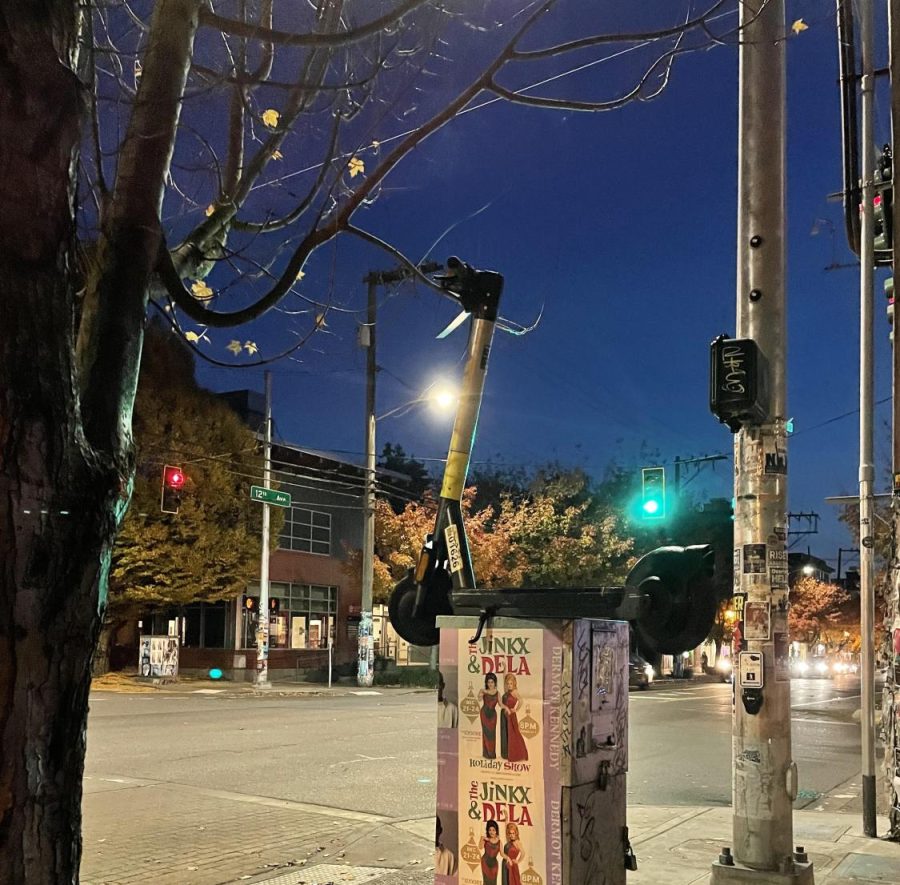Scooters and E-Bikes On-Campus: Helpful or Harmful?
In my time in person at Seattle University, scooters and e-bikes have exploded onto our campus scenery. Students use scooters and e-bikes to get to class on time or to get around Seattle. Ride sharing technology, such as e-bikes and scooters, has great potential to decrease the number of cars on the road and ultimately curb carbon emissions. However, scooters and e-bikes have been causing more harm than good on our campus, affecting campus safety, accessibility and beauty. I propose that Seattle U institute more stringent policies that limit the use of these scooters and e-bikes on campus.
Seattle U already has some guidelines in place relating to the use of scooters on campus. Seattle U’s policy reads: “The use of electric scooters and hoverboards is not permitted on Seattle University owned, leased or managed property, including in publicly accessible outdoor areas.” While this rule is in place, there has been little action to enforce or implement these plans.
Ride-sharing companies, such as Lime or Bird, work in collaboration with the City of Seattle to establish e-bike and scooter use regulation zones as a condition of their operation in Seattle. Due to this connection, relevant stakeholders, such as Seattle U, should collaborate with the city to establish regulation zones. There are three types of zones relevant stakeholders may establish in collaboration with the city: No Ride Zones, No Parking Zones and Slow Ride Zones, which limit the speed to seven mph.
Campus safety issues arise when bikes and scooters speed through campus—usually with riders lacking a helmet. E-bikes and scooters’ top speeds are reported to be between 15 to17 mph. For reference, campus vehicle speeds on campus are limited to five mph, a little faster than walking speed. This top speed does not take into consideration the hills on-campus, which can naturally cause both scooters and e-bikes to reach higher speeds.
These high speeds create an anti-pedestrian climate on campus. In too many instances I have seen scooters or e-bikes zipping through crowds or main campus walkway intersections, narrowly missing pedestrians or other obstacles. As we get into the icier months, scooter and e-bike speeds on campus could create disastrous effects. In the event of a crash, the speeds of these vehicles can cause major injuries to students, faculty, staff and campus visitors.
I would like to ask you, the reader, to reflect: Do you wear a helmet when using e-bikes or scooters? How often do you see others using helmets when in use of e-bikes or scooters? At least in my observation, the majority (if not all) of ride-share scooters and e-bike users on campus do not wear a helmet, putting them and others at risk in the event of a crash or fall.
Especially when considering the heavy foot traffic on campus, un-helmeted scooter and e-bike riders pose a serious risk to pedestrians and themselves. Noting the speeds of scooters and e-bikes and the lack of helmets, these types of collisions have the potential to cause serious injury or death.
Scooters and e-bikes are strewn across campus, perhaps due to the in-app directions to simply park them wherever you end the ride. This poses an accessibility issue. In one instance, I found three scooters and one e-bike parked in front of the Madison Portal, the campus opening from Madison ave to the upper mall. The entrance was completely blocked by the careless parking of those ride-share users to an extent that someone using a mobility aid, such as a wheelchair could not reasonably get past without moving them manually, which is in some cases not possible for those with a disability. In other instances, I have found scooters or e-bikes blocking ramps and other walkways, making it impossible for those who are handicapped to be mobile on our campus.
In addition to accessibility issues, scooters and e-bikes are also thrown into the landscape, tossed over walkways and littered around our campus. This reduces the natural beauty of our campus, especially when damaging our campus green spaces. Perhaps if scooters and e-bikes were not parked on campus, this issue could be resolved.
Some may worry that not being able to park scooters on campus would make them late to class. However, on a campus that Google Maps estimates to take six minutes to walk from the Administration building to Cherry and 12th (even allotting a generous 15 minutes), this fear pales in comparison to the many issues scooters and e-bikes bring to campus.
I would like to see Seattle University address this issue, as is consistent with existing university policies. I suggest that we come together as a community to determine the best policy to address the issues I have outlined above. As I have said, Seattle U can implement a No Ride zone, No Parking zone and/or a Slow Zone (7mph).
There are some things students can do as well. Wearing helmets, limiting speeds and being conscious of where you leave your scooter or e-bikes can all have meaningful effects on campus safety, accessibility, and beauty. I would also challenge students to try not using scooters or e-bikes on campus in general, especially in the coming icier months.
These are just some of the ways Seattle U and its community can help with this issue on campus. As I begin to work with Seattle U’s Student Government, Seattle U administration and the City of Seattle, I welcome and look forward to perspectives from everyone in the Seattle U community on this issue.


